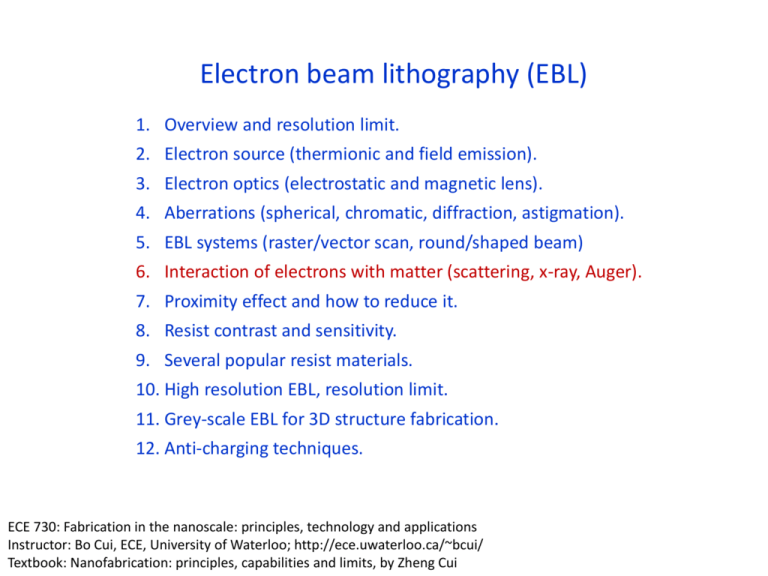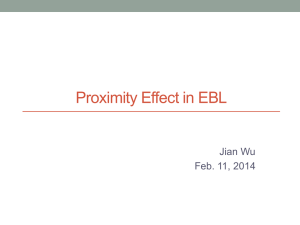Electron beam lithography_2
advertisement

Electron beam lithography (EBL) 1. Overview and resolution limit. 2. Electron source (thermionic and field emission). 3. Electron optics (electrostatic and magnetic lens). 4. Aberrations (spherical, chromatic, diffraction, astigmation). 5. EBL systems (raster/vector scan, round/shaped beam) 6. Interaction of electrons with matter (scattering, x-ray, Auger). 7. Proximity effect and how to reduce it. 8. Resist contrast and sensitivity. 9. Several popular resist materials. 10. High resolution EBL, resolution limit. 11. Grey-scale EBL for 3D structure fabrication. 12. Anti-charging techniques. ECE 730: Fabrication in the nanoscale: principles, technology and applications Instructor: Bo Cui, ECE, University of Waterloo; http://ece.uwaterloo.ca/~bcui/ Textbook: Nanofabrication: principles, capabilities and limits, by Zheng Cui Interactions of electrons with matter • Unlike X-rays, electrons interact very strongly with matter • Elastic scattering (i.e. no loss of energy) of electrons can be treated classically as a form of Rutherford backscattering • Inelastic scattering arises from numerous interactions: o o o o Low energy secondary electrons generation. Inner shell excitations (x-ray fluorescence and Auger electrons) Electron-hole pair creation and recombination Phonon excitation (heat) 2 Information from electron beam-specimen interactions When electron beam strikes the sample, both photon and electron signals are emitted. 3 Interaction volume 4 Which region is for which application Secondary electron (SE) region for imaging Back-scattered electron (BSE) region for imaging (SE is actually produced wherever primary electron goes, but only those near surface can go out to reach SE detector for imaging) (Again, BSE is actually produced wherever primary electron goes. It has higher energy, so travel longer than SE) Best spatial resolution for SEM Better Z contrast for SEM (brighter for higher Z) X-ray region for EDX (x-ray is actually produced wherever primary electron goes. It travels/ penetrates even farther than BSE) Best analytical for EDX BSE has lower resolution than SE signal, and is used only when chemical (Z) contrast is wanted. TEM (transmission EM) gives much higher resolution than SEM because of the much lower interaction volume of the high energy electrons (200keV!) passing the thin samples. X-ray generation by electron bombardment Energy levels: En 2 Z 13.56 n2 1 is due to screening (=0 for ideal model). n=1 (K-shell), 2 (L-shell), 3 (M-shell)…. Emitted x-ray energy Ex-ray K: Ex-ray=E1-E2 K: Ex-ray=E1-E3 L: Ex-ray=E2-E3 …. 6 Energy-dispersive x-ray spectroscopy (EDS, EDX) • SEM is often equipped with EDX that detect x-ray emitted (needs only extra $50K). • Each element has its characteristic x-ray, so EDX is for elemental analysis. • Since both primary electrons and emitted x-ray can penetrate certain depth (up to many m), EDX is not for top surface analysis (AES is, see next slides). • The principle is the same as electron impact x-ray source, but here a focused electron beam is used to “impact or bombard” the sample. • Light element (Z4) usually cannot be detected, since their characteristic energy is lower and thus cannot go through the x-ray detector window. (We know that longer wavelength shorter attenuation/penetration length). • EDX is similar to x-ray fluorescence (XRF). The only difference is that, for EDX inner shell electrons are kicked off by high energy electrons; for XRF it is by high energy x-ray with energy emitted characteristic x-ray energy, or even by -ray. EDX analysis of a material The peak for W could be L (its K energy is much higher) 7 Auger electron emission Kick off electron For AES For EDX Fluorescence and Auger electron yields as a function of atomic number for K shell vacancies. Kinetic energy of ejected electron: Ekin = ECore State − EB − EC' ECore State, EB, EC': core level (here n=1), first outer shell (n=2), second outer shell (n=2) electron energies. (ECore State − EB is the same energy as the characteristic x-ray energy) Since orbital energies are unique to an atom of a specific element, analysis of the energy of ejected electrons can yield information about the chemical composition of a surface. http://en.wikipedia.org/wiki/Auger_electron_spectroscopy Auger Electron Spectroscopy (AES) Attenuation length as a function of energy (depends on Z) Auger spectrum of a copper nitride film (weak signal, often need derivative to show the peaks) 1-10 monolayer sampling depth Auger electron from Briggs and Seah, Practical Surface Analysis 2nd Edition John Wiley & Sons, 1990, p. 207. Electron energy (eV) • AES is good for light element (e.g. Li) where Auger electron dominate x-ray emission yield. • It is for surface analysis, able to analyze only the top surface (2-5nm). • Scanning Auger Microscope (SAM) is a type of AES, but with focused electron beam to give high resolution spatial information of element distribution. 9 Electron beam lithography (EBL) 1. Overview and resolution limit. 2. Electron source (thermionic and field emission). 3. Electron optics (electrostatic and magnetic lens). 4. Aberrations (spherical, chromatic, diffraction, astigmation). 5. EBL systems (raster/vector scan, round/shaped beam) 6. Interaction of electrons with matter (scattering, x-ray, Auger). 7. Proximity effect and how to reduce it. 8. Resist contrast and sensitivity. 9. Several popular resist materials. 10. High resolution EBL, resolution limit. 11. Grey-scale EBL for 3D structure fabrication. 12. Anti-charging techniques. 10 Forward/back scattering events Scattering: spreading of the beam, lost of resolution Resist Substrate Forward scattering Back scattering (by nucleus) Properties: Properties: Occasionally (collision with nucleus) Very often Large angles, thus mainly elastic Small angle High energy, same range as primary electrons. Very inelastic (i.e. lose energy) Generation of SE (secondary electrons) Large travel length, cause proximity effect. with low energy. Backscattering is responsible for resist exposure far from incidence (proximity effect), as BSE can generate SE along its path to expose the resist there. Forward/back scattering events Energy spectrum of electrons emitted from substrate SE: secondary electron; BSE: backscattered electrons Energy of primary electrons Auger electrons There is no clear-cut distinction of SE and BSE. Typically energy < 50eV is “called” SE. SE with several eV are responsible for most (not all) resist exposure. Such SE diffuses laterally a few nm, which is one limiting factor for ultra-high resolution EBL. Monte-Carlo simulations of electron trajectory Scattering probability varies as square of atomic number Z, and inversely as the incident kinetic energy. Penetration depth decrease with Z. Low Z High Z Number of backscattered electrons is not so dependent on energy, but its spatial distribution is. Proximity effects are “diluted” (spread over larger area) at high energies. 13 (Sensitivity) (penetration depth) Effect of voltage on dose • At small kV, penetration depth is low, so cannot expose thick resist. (e.g. at 0.8kV, penetration depth only 40nm in PMMA). • At >2kV, resist sensitivity is higher for lower kV, so faster writing. • But lower kV has larger beam spot size due to aberrations, and more serious forward scattering, both of which reduces resolution. • In addition, lower kV has lower attainable beam current that reduces writing speed. • Therefore, typical EBL is done at >3kV. 14 Double Gaussian model The curve are in log scale(!!) Bad fit here Forward scattering 1 f (r ) (1 ) 1 r 2 r 2 2 exp 2 exp : range of forward scattering (in m) : range of backscattering (in m) : ratio of backscattering to forward scattering Backscattering 15 Proximity effect (similar to that in OPC – optical proximity correction) Real dose D=E(1+b) E is as-exposed dose b is due to proximity effect b2 (not small) for large area exposure Area in-between exposed by proximity effect • Proximity effect is negligible for isolated/sparse fine features. • It is good for areal exposure (e.g. a big square >>1m), since pixel can be much larger than beam spot size (right figure). E.g., beam step size (pixel) of 50nm is usually enough to give uniform areal exposure, even with a beam spot size only 5nm. 16 • Proximity effect is worst for dense and fine patterns, such as grating with sub-50nm pitch. Resist profile A thin layer may be developed due to exposure by proximity effect • Due to forward scattering and (to a less degree) proximity effect, positive resist has always an undercut profile, good for liftoff. • Negative resist always has a tapered profile, bad for liftoff. • For patterning dense fine features, an undercut profile often causes resist structure to collapse due to capillary force when developer is dried. Original thickness Developed profile Resist Substrate Positive resist • That is, proximity effect makes patterning dense fine features difficult. Dense AND fine structures substrate Resist (positive) profile, not mechanically stable Negative resist 17 How to reduce proximity effects (extremely high resolution, 1.5nm, see later slide for resist) 18 Eliminate proximity effect using resist on membrane (a)Standard PMMA-SiO2-Si+ substrate. An incident electron beam "forward-scatters" slightly in the PMMA and SiO2 layers. Strong scattering in the Si+ results in broadly distributed "back-scattered" electrons which expose a wide region of the PMMA. (b)PMMA-Si3N4 substrate used to make nanogaps with EBL. Two nearby areas are shown being sequentially exposed to an electron TEM image of nano-gaps beam while the small "nanogap" region between them is left with gaps 0.7-6nm unexposed. Fischbein, “Nanogaps by direct lithography for high-resolution imaging and electronic characterization of nanostructures”, APL 88, 063116 (2006) Proximity effect correction Similar idea to OPC (optical proximity correction), but here proximity extends many m, depending on beam energy and substrate material (atomic number Z). 20 Electron beam lithography (EBL) 1. Overview and resolution limit. 2. Electron source (thermionic and field emission). 3. Electron optics (electrostatic and magnetic lens). 4. Aberrations (spherical, chromatic, diffraction, astigmation). 5. EBL systems (raster/vector scan, round/shaped beam) 6. Interaction of electrons with matter (scattering, x-ray, Auger). 7. Proximity effect and how to reduce it. 8. Resist contrast and sensitivity. 9. Several popular resist materials. 10. High resolution EBL, resolution limit. 11. Grey-scale EBL for 3D structure fabrication. 12. Anti-charging techniques. 21 EBL resist: sensitivity and contrast Resist development curves: (a) Resist A is of higher sensitivity than B. (b) A is of higher contrast than B; C is negative resist. Here D1 and D0 is defined for B negative positive thickness substrate Sensitivity: • For positive resist: D1 value; or dose required to fully develop the resist to bottom, which is usually close to D1 value. • For negative resist: dose that results in half resist thickness remaining after development. Contrast : defined as slope of the development curve. 1 log 10 D1 / D0 For “perfect” resist, D1=D0, so . Usually >2.0 is good For PMMA, =5-10. 22 Positive vs. negative resist Positive resist (trench) Negative resist (line) Which (positive or negative) resist to choose • Which resist to choose depends on which will give the minimum exposure area/time. • For isolated sparse features, positive resist is suitable for liftoff process, while negative for direct etch process. • To pattern Si (or SiO2…), either Cr liftoff then RIE using Cr as mask, or direct etch of Si using resist as mask will work, though Si can be etched deeper with more vertical sidewall using Cr as mask. Liftoff process using positive resist Direct etch process using negative resist Resist 1. Spin on positive resist 1. Spin on negative resist 2. EBL 2. EBL 3. Cr deposition 3. RIE substrate 4. Liftoff Cr 5. RIE substrate using Cr as mask (not shown) 24 Resist tone reversal process Very useful if one has only one cheap positive resist: PMMA Resist Under-layer (polymer such as PMGI) substrate Profile in resist Profile in underlayer substrate For positive resist, trench (or hole) formed after EBL. substrate Liftoff a hard material (Cr, SiO2) substrate substrate After metal liftoff RIE under-layer. The resulted polymer structure is a line (or pillar), as if negative resist were used. Hole array in 100nm-thick Au with pitch 600nm. 25 Sensitivity Sensitivity depends on: 1. Electron energy keV (or acceleration voltage kV). Higher energy requires higher exposure dose, so lower sensitivity. 2. For example, sensitivity for PMMA is 250C/cm2 with 30kV, but 600 C/cm2 with 100kV (high energy electrons pass fast through the resist, generating fewer low energy secondary electron (SE) to expose the resist, or they are just not efficient to generate SE due to the large energy difference. 3. Substrate material: high density substrate (high Z) material results in more back scattering of electrons into resist layers, leading to higher sensitivity (e.g. PMMA on Au sensitivity is 2 that on Si). But of course more severe proximity effect. 4. Process conditions: post exposure baking conditions for chemically amplified resist; strength of developer, development temperature and time. (sensitivity 0C/cm2 (!!) if developed infinitely long time) 5. Developer used. For example, PMGI sensitivity 50C/cm2 when using base developer, 1000C/cm2 when using solvent developer. (PMGI: Poly(dimethyl glutarimide)) Note: higher sensitivity means one needs lower dose to fully expose the resist. Bo Cui, Teodor Veres, “High resolution electron beam lithography of PMGI using solvent developers”, Microelectronic Engineering, 2008. 26 Contrast Low contrast resist profile Contrast curve of SU-8 Contrast only 0.92 High contrast resist profile High contrast: • Steeper sidewalls • Greater process latitude • Better resolution • Higher aspect ratio structure • Less sensitive to proximity effect, higher density pattern. Low contrast: good only for 3D gray scale lithography 27 Sensitivity vs. contrast: a dilemma L: resolution D: dose (sensitivity) This dilemma is similar to that for EUV resist, where due to shot/statistically noise, higher sensitivity has higher LER (line-edge roughness). In fact, shot noise is also important for EBL when using very sensitive resists. (sensitivity) Ocola LE and Stein A, JVST B, 24(6), 3061-3065 (2006). No resist has both high sensitivity and high contrast/resolution. This is not always that bad, because, anyway, even though such resist exist, it cannot be exposed using an inexpensive EBL system – too short dwell time (since high sensitivity) for exposing each tiny pixel (since high resolution), that beam blanker cannot follow. 28 Electron beam lithography (EBL) 1. Overview and resolution limit. 2. Electron source (thermionic and field emission). 3. Electron optics (electrostatic and magnetic lens). 4. Aberrations (spherical, chromatic, diffraction, astigmation). 5. EBL systems (raster/vector scan, round/shaped beam) 6. Interaction of electrons with matter (scattering, x-ray, Auger). 7. Proximity effect and how to reduce it. 8. Resist contrast and sensitivity. 9. Several popular resist materials. 10. High resolution EBL, resolution limit. 11. Grey-scale EBL for 3D structure fabrication. 12. Anti-charging techniques. 29 Conventional and chemically amplified resists They are more popular 30 The standard EBL resist: PMMA (positive) • The most popular e-beam resist, very cheap and last forever, easy handling. • Very high-resolution and contrast. • Typical molecular weight is 950kg/mol. Lower Mw (e.g. 15kg/mol) leads to higher sensitivity but lower contrast. • Usually dissolved in a solvent: chlorobenzene, or anisole (less toxic, 2-4%). • Developer mixtures can be adjusted to control contrast and sensitivity. • The downside: low sensitivity, poor dry etch resistance (good for liftoff, not for direct etch pattern transfer). 31 PMMA developer (MIBK: methyl isobutyl ketone) The dilemma again: higher sensitivity comes with lower contrast 1. MIBK : IPA (isopropanol)=1:3 for typically 60sec, most popular developer. 2. Cellosolve (2-ethoxyethanol): methanol=3:7 for 7-10sec, claimed by some to have slightly higher contrast than MIBK. 3. MEK (methyl ethyl ketone) : ethanol=26.5:73.5 for 2-5 second also works well. 4. IPA : H2O=7:3, co-solvent system, i.e. neither IPA nor water alone dissolves exposed PMMA. Claimed by some to have better performance than MIBK. [1] “Enhanced sensitivity in the electron beam resist PMMA using improved solvent developer”, Mohsin and Cowie, Polymer, 1988, page 2130. [2] “New high-contrast developers for PMMA”, Bernstein and Hill and Liu, J Appl. Phys., 71(8), 1992, page 4066. 32 [3] “Comparison of MIBK/IPA and water/IPA as PMMA developers…”, Microelectronic Engineering, 61-62, 745-753 (2002). PMMA dose table 10kV 20kV 30kV Area dose (C/cm2) 100 180 250 Line dose (nC/cm) 0.5 0.9 1.3 Dot dose (fC) 1.5 Doses for MIBK:IPA=1:3 developer 60second. All values are good starting points, need dose test before each writing. Use the above area dose only for large features (>proximity effect range). Otherwise, e.g. when writing 1m stripes, 250C/cm2 is not enough. Proximity effect factor b can be estimated (very roughly) from the above table: Real dose D=E(1+b) E is as-exposed dose b is due to proximity effect For line dose 1.3nC/cm, written line-width is 15nm. So area dose 1.3nC/(15nm1cm)=867C/cm2. Therefore, 1+b=867/250, so b=2.5 (not small) b=1.7 if estimated from the dot dose ((15nm)2 dot). 33 The most popular commercial resist: Zep-520 (positive) • Developed by ZEON in Japan to replace PMMA. • Higher sensitivity (3-5x faster), and higher etch resistance (3x) • For ultrahigh resolution (sub-10nm), PMMA might still be better. • Expensive: $1000/100ml. • One-year shelf time, making it more expensive compared to PMMA. • Composition: methyl styrene/chloromethyl acrylate copolymer. Developer: • ZED-N50 (100% n-Amyl Acetate) • Xylene (o-,m-,p- mixed) Solvent: Anisole, for liftoff or diluting the resist for thinner film. Line in ZEP-520 written at 75keV. Resist thickness 1.5m, line-width 50nm 34 HSQ: hydrogen silsesquioxane (negative) • Silicon dioxide based inorganic material (not polymer). • Sensitivity and contrast similar to that of PMMA (depends on developer strength). • Very high resolution and very dense pattern when using <25nm-thick film. • Exposed HSQ is in the form of amorphous oxide, good etching mask. • It is an unusual resist: development by chemical reaction (un-exposed HSQ reacts with diluted NH4OH or NaOH developer to produce H2), not by dissolution; and development “saturates” (i.e. no more reaction) after a certain time. • Salty developer (add NaCl to NaOH solution) increases contrast. HSQ structure, Product of Dow Corning under product code Fox12™ 35 Contrast curves of HSQ Contrast curves of HSQ at different development temperatures Contrast curves of HSQ at different exposure energies High T higher contrast HSQ is not stable. So spin-coating, baking, writing and development must be done quickly. Sub-10nm lines in HSQ E.g. 1 hour delay for development can increase feature size by 60%. It is worse for delay between sample preparation and e-beam writing. Clark, “Time-dependent exposure dose of hydrogen silsesquioxane…”, JVST B, 24(6), 3073-3076 (2006). 36 SU-8 (very high sensitivity, but low contrast) • • • • • Chemically amplified negative tone resist Extremely high sensitivity – over 100x that of PMMA Low contrast (0.9), unsuitable for dense patterning High resolution possible for sparse patterns at high kV Rough edges and “residues” due to random exposure from back scattering electrons and random photo-acid diffusion. (this is like shot noise for EUV resist that is also chemically amplified) • Ideal for low resolution writing over large area (since it is fast). “residues” 50keV 10keV Rough edge 100keV High resolution sparse pattern 24nm line at pitch 300nm in 100nm thick SU-8 37 in Kristensen A, “High resolution 100 kV electron beam lithography SU-8”, Microelectronic Engineering, 83, 1609-1612(2006) SU-8 resist formulation and process Epoxy-based, mostly used as photo-resist Glass transition temperature of SU-8 Un-cross-linked: 50oC. Fully cross-linked: 230oC • Like all chemically amplified resist, post exposure baking temperature and time is very critical. Typically 90oC for 2-3min on hotplate. • Spin-coating, bake, exposure, post-bake and development need to be done quickly without much delay. • As it is so sensitive, don’t let it exposed to room light for long (will be exposed by UV light, even though room light has very little UV component in it). 38 Undercut profile for liftoff Metal liftoff process Microelectronic Engineering, 73-74, 278281 (2004). PMMA LOR Process of double layer stack for easy liftoff LOR contains PMGI plus additives 39 Extremely high resolution, since only primary (not secondary) high energy beam is responsible for exposure. However, probably HSQ is the only useful inorganic resist. Inorganic resists listed here: very thin film, making liftoff difficult; very low sensitivity, need long writing time. 40



